Modelado y control de temperatura para una clase de sistema derivado de la ley de enfriamiento de Newton
DOI:
https://doi.org/10.29057/icbi.v10iEspecial4.8950Palabras clave:
control, temperatura, ley de enfriamiento de Newton, Regulador cuadrático linealResumen
En este trabajo se presenta el modelado y el control para una clase de sistema derivado de la ley de enfriamiento de Newton En este artículo un sistema térmico es representado mediante un modelo de parámetros concentrados, cuyas sustancias se caracterizan por una resistencia al flujo de calor tienen una capacitancia térmica, que por lo común tienen perdida de calor. Por lo tanto, se requiere implementar una clase de controlador que permita optimizar la función de costo y permita aprovechar el rendimiento con la menor perdida de energía. Para satisfacer lo anterior, se emplea un controlador proporcional derivativo (PD) bajo la sintonización de un regulador cuadrático lineal (LQR) que permite minimizar el criterio de desempeño. Los resultados son llevados a cabo mediante experimentos en tiempo real mediante el uso de Matlab, Arduino Uno y el termostato W1209. Finalmente, en el artículo son presentados los resultados experimentales y las conclusiones correspondientes, que permiten validar el desempeño del modelo propuesto y el controlador implementado.
Descargas
Información de Publicación
Perfiles de revisores N/D
Declaraciones del autor
Indexado en
- Sociedad académica
- N/D
Citas
Arduino, (2020). Software y Hardware de Ardunio UNO. Disponible en: https://www.arduino.cc
Arduino IO package Simulink. Librerías para Arduino en Matlab-Simulink. (2020). Disponible en: https://www.mathworks.com/matlabcentral/answers/34672-arduino-io-package-simulink
Benitez, I. O., Rivas, R., Feliu, V., Sanchez, L. P. & Sanchez, L. A. (2016). Fuzzy Gain Scheduled Smith Predictor for Temperature Control in an Industrial Steel Slab Reheating Furnace, IEEE Latin America Transactions, vol. 14, no. 11, pp. 4439-4447. DOI: 10.1109/TLA.2016.7795812.
Benítez González, I. O., Rivas Pérez, R., Feliu Batlle, V. & Castillo Garcia, F. J. (2015). Temperature Control Based on a Modified Smith Predictor for Injectable Drug Formulations, IEEE Latin America Transactions, vol. 13, no. 4, pp. 1041-1047. DOI: 10.1109/TLA.2015.7106355.
Boyles, Justin G., Levesque, Danielle L., Nowack, Julia; Wojciechowski, Michał S., Stawski, Clare, Fuller, Andrea, Smit, Ben &Tattersall, Glenn. (2019). Efficiency and its bounds for thermal engines at maximum power using Newton’s law of cooling, Journal Ecology & Evolution, vol. 9, no. 21, pp. 12020-12025. DOI: 10.1002/ece3.5721.
Jain, Dilip & Pathare, Pankaj. (2007). Modeling of the internal Cooling of Fish during Ice Storage," in International Journal of Food Engineering, vol. 3, no. 4, pp. 1-13, 2007, DOI: 10.2202/1556-3758.1131.
Kemper, A., Wöbbekind, M., Büskens, C., & Schollmeyer, M. (2013). LQR control for a Diesel engine’s air system, Proceedings in Applied Mathematics and Mechanics, vol. 13, no. 1, pp. 473–474.
Mondol, A., Gupta, R., Dutta, T. & Das, S. (2018). An insight into Newton’s cooling law using fractional calculus, Journal of Applied Physics, vol. 123, no. 6. DOI: 10.1063/1.4998236.
Ogata, K. (2010). Modern Control Engineering. Prentice Hall, 5th edition, Madrid, España.
Qiang, H. (2014). Modeling and Simulation of LQR Control for DC Motor, Applied Mechanics and Materials, vol.668-669, pp. 486-489. ISSN: 1660-9336, Publisher: Trans Tech Publications Country of Publication: Switzerlan.
Rezende, Enrico & Bacigalupe, L. (2015). Thermoregulation in endotherms: physiological principles and ecological consequences, Journal of Comparative Physiology B: Biochemical, Systemic & Environmental Physiology, vol. 5, no. 7, pp. 709-727. DOI: 10.1007/s00360-015-0909-5.
Salcedo, Hernández J., Rivas-Pérez, R & Sotomayor Moriano, J. J. (2018). Design of a Generalized Predictive Controller for Temperature Control in a Cement Rotary Kiln, IEEE Latin America Transactions, vol. 16, no. 4, pp. 1015-1021. DOI: 10.1109/TLA.2018.8362131.
Santos, C. F., Ancines, C. A. & Krenzinger, A. (2018). Temperature Controller for Simultaneously Test of Solar Collectors in Series, IEEE Latin America Transactions, vol. 16, no. 6, pp. 1708-1714. DOI: 10.1109/TLA.2018.8444390.
Su, J., Kochan, O., Chunzhi, Wang & Kochan, R. (2018). An insight into Newton’s colling law using fractional calculus, Measurement Science Review, vol. 15, no. 6, pp. 304-312. DOI: 10.1515/msr-2015-0041.
Teppa Garran, P., Nardone, V. & Rodríguez Diez, J. (2015). LQR Control Employing Output Derivative Measures, IEEE Latin America Transactions, vol. 13, no. 8, pp. 2538-2544. DOI. 10.1109/TLA.2015.7331909.
Termostato W1209. (2020). Manual de uso del Termostato W1209. Disponible en: https://mvelectronica.com/download-product-file/W1209/Manual%20w1209%20(2021-02-09%2017-38-36).pdf
Torres, W. L., Araujo, I. B. Q., Menezes Filho, J. B. & Costa Junior, A. G. (2017). Mathematical Modeling and PID Controller Parameter Tuning in a Didactic Thermal Plant, IEEE Latin America Transactions, vol. 15, no. 7, pp. 1250-1256. DOI: 10.1109/TLA.2017.7959343.
Viana Fonseca, J., Silva Abreu, I., Moraes Rego, P. H., Melo Wolff, M. d. P. & Silva, O. F. (2008). A Genetic Algorithm Convergence and Models for Eigenstructure Assignment via Linear Quadratic Regulator (LQR), IEEE Latin America Transactions, vol. 6, no. 1, pp. 1-9. DOI. 10.1109/TLA.2008.4461626.
Villar, J. R., De la Cal, E. & Sedano, J. (2008). Energy Saving by Means of Multiagent Systems and Fuzzy Systems, IEEE Latin America Transactions, vol. 6, no. 6, pp. 517-523. DOI: 10.1109/TLA.2008.4908184.
Yan, H. & Guo, H. (2012). Efficiency and its bounds for thermal engines at maximum power using Newton’s law of cooling, Physical Review. E, Statistical, Nonlinear, and Soft Matter Physics, vol. 123, no. 6.




















